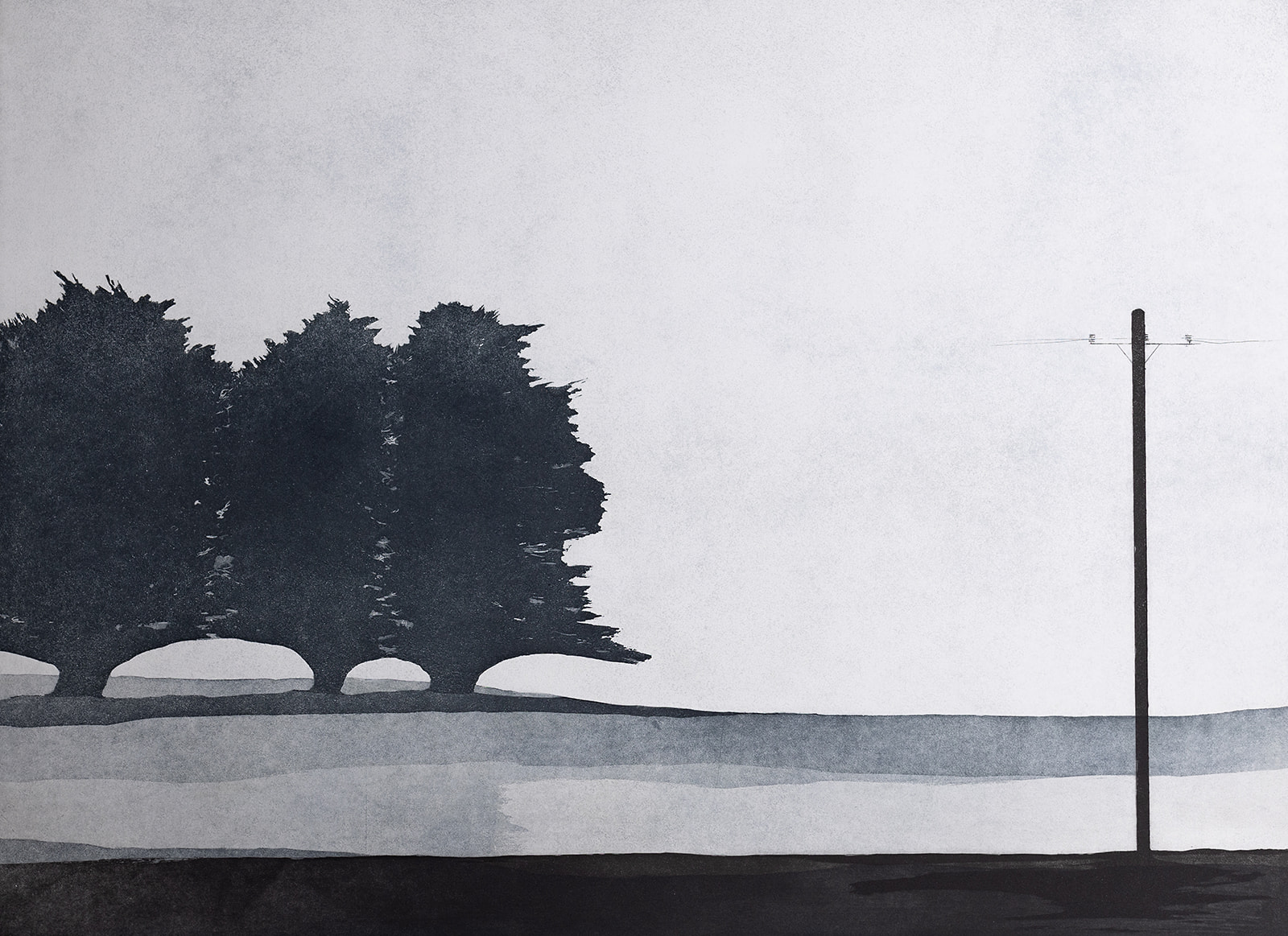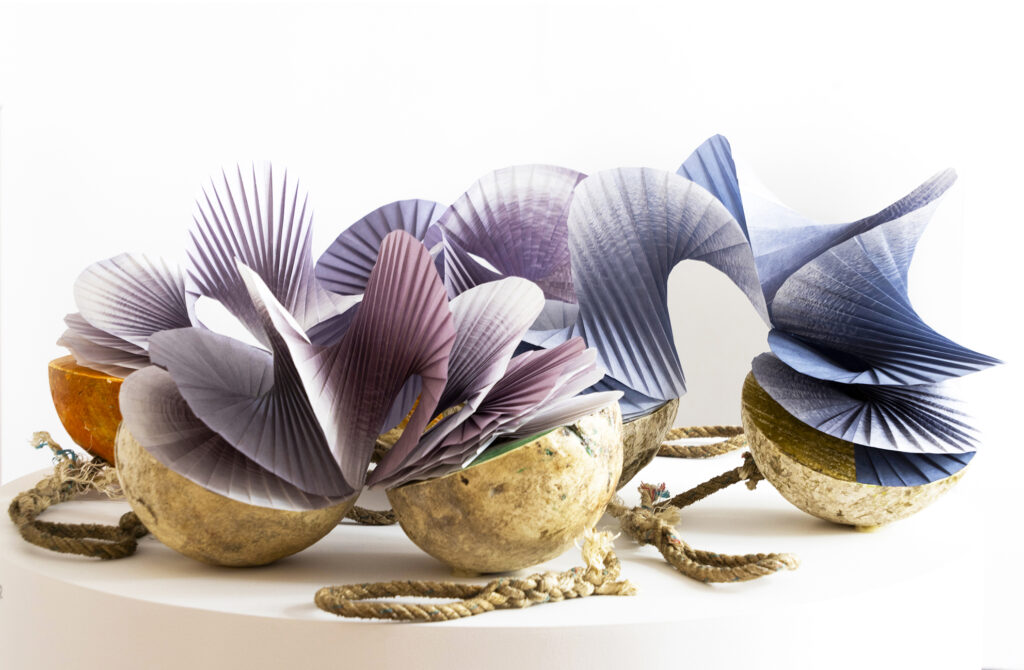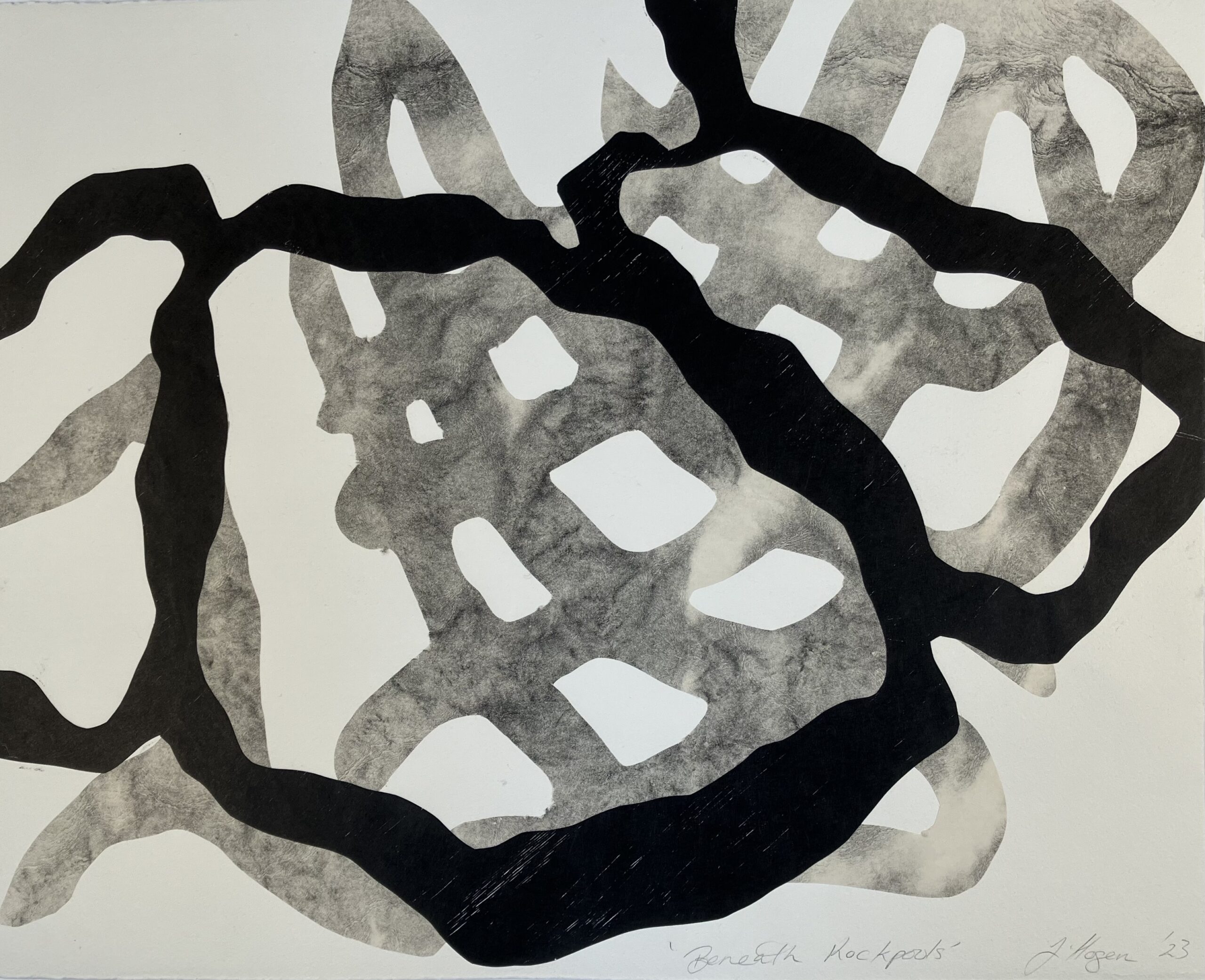
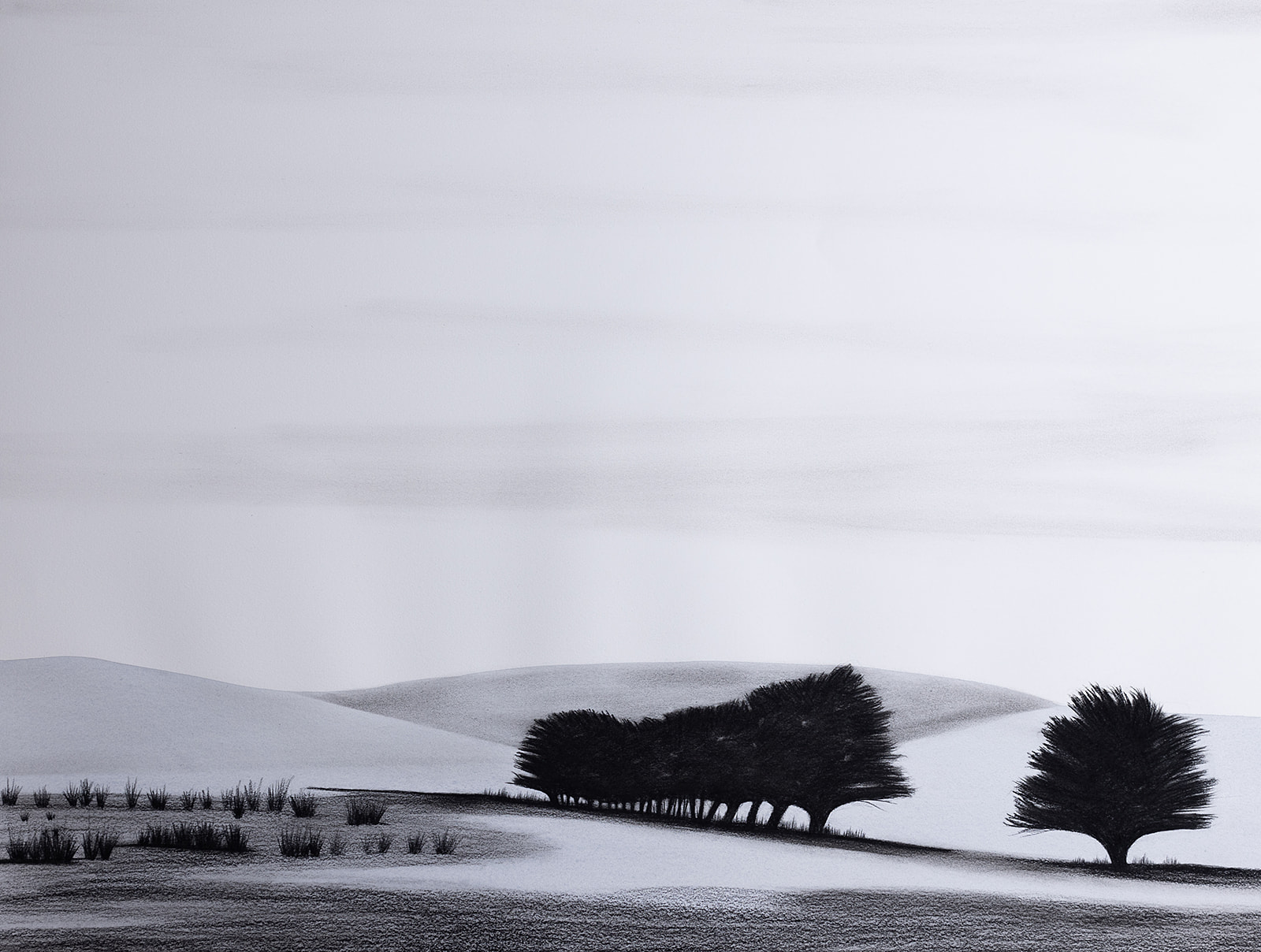
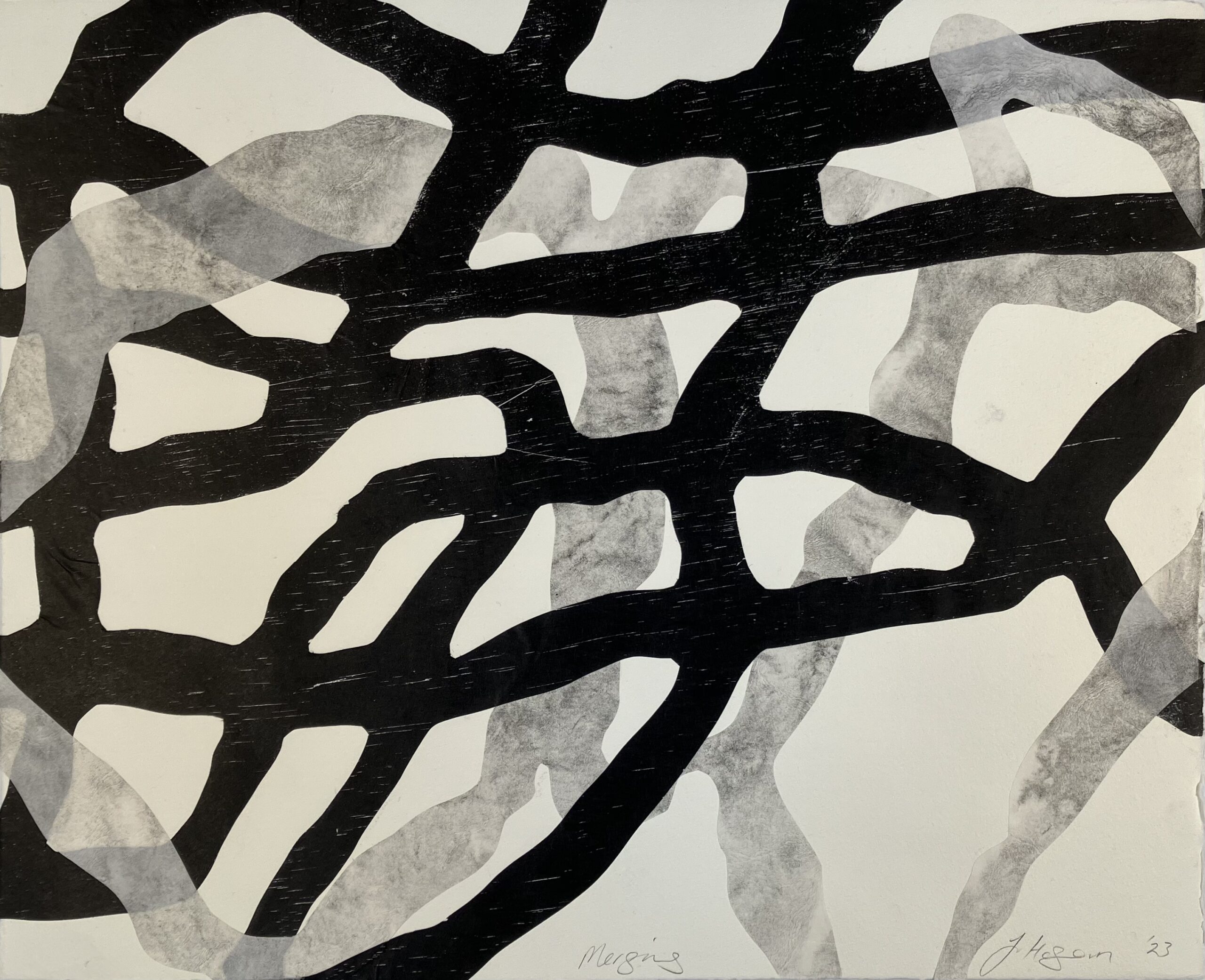
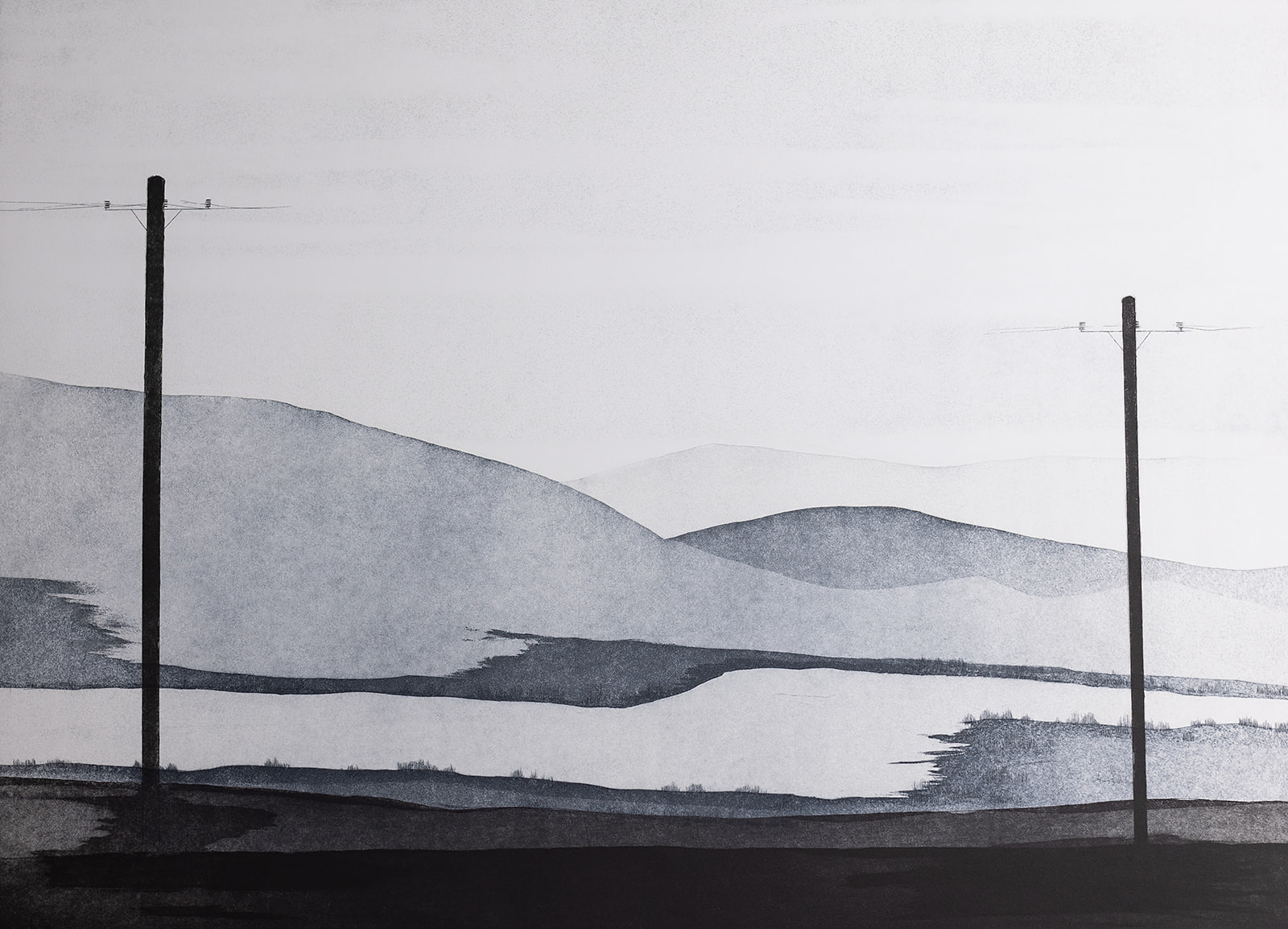
From top:
Olivia Moroney, 2023, Arrival, aquatint and etching, 60 x 80 cm, ed.10
Jan Hogan, Beneath Rockpools, 40 x 50 cm
Olivia Moroney, 2023, as we seek shelter, watercolour and charcoal, 60 x 80 cm
Jan Hogan, Merging, 40 x 50 cm
Olivia Moroney, 2023, Where the valley takes us 4, unique state aquatint and etching, 60 x 80 cm
Q: Your exhibition is called from the source how is that expressed in the artworks you have both made?
OM: from the source for relates to venturing out and seeing the landscape, it is about going out to the sources of inspiration. Finding places in the landscape I am drawn to depict in both drawings and prints. I come to know these places by moving through the landscape, by walking, driving and just being. These places and landscapes become more and more familiar with each visit.
JH: from the source is about daily interactions with the Derwent River. Each day she immerses herself in the Derwent River after a gentle walk along the shore with her dog. The dog swims out and sits on a rock, keeping guard as she dives under and tracks along the rocky outcrops to a favoured mossy ledge where she attempts to stand, depending on tides, currents, and winds. In daily drawings she considers the constant interplay between stone and water that has formed the bay and the smaller rock fragments that she gathers for a brief moment in time. Holding smaller rocks in her hand she imagines navigating their internal accumulations and folds whilst their shadows remind her of their material presence. Printmaking allows her to witness the agency of matter as water forms the patterns in the wood and in the lithographic tusche washes. From these printmaking grounds her drawings transform into lines that trace her swims, the rocks, and the seaweeds, that accumulate along the intertidal zone. The processes of drawing and printmaking assist her in entering this watery realm.
Q: How did the artwork selection take place?
OM: After spending time in the landscape and recording it through drawing, looking at the shapes of trees, power poles and tonal variations in the landscape, larger plans for both the prints and drawings were made. Then the process of etching began, where a fine ground for the aquatint is put of the plates and the process of block out etching begins. The prints in this show are all aquatint plates and some have etched elements in them. In creating this show, I was interested to create a variety of plates that could be printed by overlaying them to create extra depth and movement in the landscape, that is apparent in the series of unique states called Where the valley takes us. The act of printing multiple plates in the one print also allows me to create a sense of stillness as well, as is apparent in Arrival. The drawings are begun by laying a ground of watercolour on the paper and then drawing upon this ground. During the process of making my work, I consider the ground in which I work upon and into, while representing the ground I have been immersed in.
JH: Jan initially started doing small collages that combined lithographic chine colle with woodcuts. She was excited by the combination of textures this provided. The lithographic tusche washes echo the tidal zone of the Derwent estuary whilst the wood cuts brought the organic texture of the plants that attach themselves to the rocks and shores of the river. From these she developed some larger works until she settled into a series of medium scale works that interweave the forms from background to foreground much as the rocks along the shore shift from land to underwater depending on the tides.
Q: How does the exhibition manifest – what do visitors experience?
JH & OM: In Jan’s work there are only subtle tonal shifts of colour from creamy lithographic chine colles to bolder black woodcuts. As the viewer wanders between the Olivia’s and Jan’s work there is a constant shifting between the macroscopic and microscopic view of the land. From travelling through and past Olivia’s landscapes, where the natural meets man made motifs found in the landscape, to hopefully soaring above and below Jan’s watery realm, the viewer is asked to question their knowledge of place.
Q: What are some of the key works and what subject matter do they deal with?
OM: I have created a series of drawings which depict places in the landscape around me. There is a series of drawings where the viewer is taken around the hedgerow in front of them. The aim of these drawings is to create a more immersive experience of being in place. Similarly in the aquatint and etching works, there is a series of images called Where the valley takes us, these works depict a landscape in which the hills recede out into the valley, in the foreground of these works are power poles, the placement of these power poles in the printed image aim to depict and create a sense of moving through the landscape as you follow the road out into the valley before you. Similarly, the artwork Arrival, aims to depict and create a sense of arriving in a familiar location, you see the old pines trees you have always seen on arrival in the landscape and the power poles have taken you into this location as you follow the road.
JH: In Jan’s series of medium scaled works such as Beneath Rockpools and Merging there is a shift between the rock forms being in a black woodcut to being flipped and becoming a lithographic chine colle. This transformation of materials and forms is a key aspect of the site that Jan is immersed in. The series of works are about the porosity between a site and all the inhabitants or visitors that develop a relationship with the site. The works delve into why we form attachments to sites that is inclusive of the geology and the more-than-human world. What are the conditions that assist in forming relationships with place and what is the knowledge contained within the site. The forms come from many iterations of drawings, woodcuts and lithographs until a resonance occurs that reveals some of the patterns and attractions of the site. The aim is to get viewers to go below the surface and immerse themselves in the multiple beings in a site. What stories will they see?
Q: What is it about the printmaking experience that you most appreciate?
OM: The printmaking experience for me all comes down to the process I am interested in using. These works are mostly aquatint plates; some elements are etching but I mostly employ the process of aquatint, as it allows me to create a variation of tone which I have witnessed in the Tasmanian landscape. I appreciate all the aspects of the printmaking experience. Wonderful things happen when you take a plate out of the acid, or when you do the first proof of a plate, there is always that question, will it come out as I indented it? Sometimes it doesn’t and that’s one of the challenges of printmaking, solving the problems or finding the solution to why something hasn’t happened as you intended. There is a lot of elements at play when you are using acids and materials. But when it does work or the images comes off the press as you intended then well it is the best feeling ever, ‘happy days’ as I say. My studio is situated in the midlands of Tasmania on a sheep farm, the weather can be harsh or fabulous at any given time. The studio is a converted shipping container, which I have slowly modified and made better and better as the years have gone on. But due to its remoteness you need to be organised and be able to adapt to problems when they arise.
I think I am mostly drawn to the printing part of the process, once the plate is made and you can then test and play with the plates, or you can work on an image and decide it is ready for editioning. I love the moment when all the proofs are pinned on the walls, and you have decided what will make the grade.
JH: Jan loves the transformation that occurs when a drawing is taken into another medium. How does the matter of stone, wood, ink and paper shift the meaning of the line and what extra knowledge does it provide about the atmospheric conditions of place?
—
Olivia Moroney and Jan Hogan’s exhibition from the source is at Handmark Gallery, until 8 May
https://handmark.com.au/exhibition/jan-hogan-olivia-moroney/
—
Join the PCA and become a member. You’ll get the fine-art quarterly print magazine Imprint, free promotion of your exhibitions, discounts on art materials and a range of other exclusive benefits.

